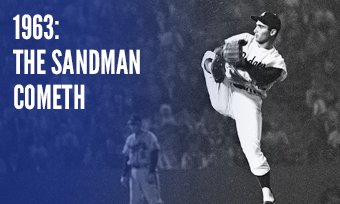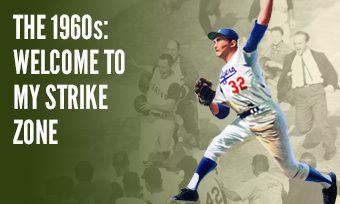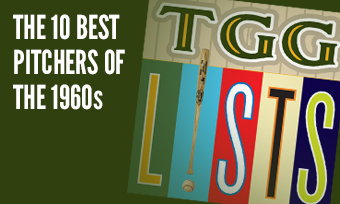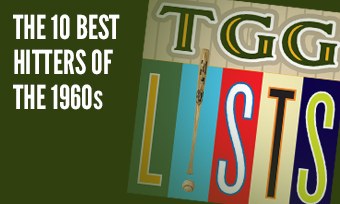The Yearly Reader
Leaders and Honors, 1963
Our list of baseball’s top 10 hitters and pitchers in both the American League and National League for the 1963 baseball season, as well as the awards and honors given to the game’s top achievers of the year.
The National League’s Top 10 Hitters, 1963
Bold type in brick red indicates league leader.
1. Hank Aaron, Milwaukee
Key Numbers: .319 average, 121 runs, 201 hits, 29 doubles, 44 home runs, 130 RBIs, 78 walks, 31 stolen bases, .586 slugging percentage.
Aaron never won a triple crown, but he came closest to one in 1963, finishing seven batting points behind NL leader Tommy Davis. He homered on the season’s final day to grab a co-share of the NL crown (with Willie McCovey), and hit a whopping .414 with runners in scoring position.
2. Willie Mays, San Francisco
Key Numbers: .314 average, 115 runs, 187 hits, 32 doubles, 7 triples, 38 home runs, 103 RBIs.
With all the power surrounding him in the lineup (Cepeda, McCovey, et al), why bother to steal bases? Mays’ eight swipes were far below the average of nearly 30 over his previous eight seasons.
3. Orlando Cepeda, San Francisco
Key Numbers: .316 average, 100 runs, 183 hits, 33 doubles, 34 home runs, 97 RBIs, 10 hit-by-pitches.
The Baby Bull raged to the finish, hitting .370 with 15 homers after July 31.
4. Willie McCovey, San Francisco
Key Numbers: .280 average, 103 runs, 19 doubles, 5 triples, 44 home runs, 102 RBIs, 11 hit-by-pitches.
In the ongoing tussle over who got to play first base for the Giants, McCovey deferred to Cepeda, took the outfield and went about leading the NL in home runs for the first of three times; 15 of his blasts took place during a 24-game hit streak, the majors’ longest in 1963.
5. Vada Pinson, Cincinnati
Key Numbers: 162 games, .313 average, 96 runs, 204 hits, 37 doubles, 14 triples, 22 home runs, 106 RBIs, 27 stolen bases.
With a fifth outstanding season to begin his career, Pinson’s path to the Hall of Fame looked to have little or no potholes—but barely age 25, this was as good as it got for him.
6. Bill White, St. Louis
Key Numbers: 162 games, .304 average, 106 runs, 200 hits, 26 doubles, 8 triples, 27 home runs, 109 RBIs.
The first baseman was the most prolific force on a Cardinals’ roster that hit (by far) a major league-best .271 and seemed immune to the big drop in offense due to the expansion of the strike zone.
7. Billy Williams, Chicago
Key Numbers: .286 average, 87 runs, 175 hits, 36 doubles, 9 triples, 25 home runs, 95 RBIs.
Williams finally gave Ernie Banks some long-sought protection—alas, just as Banks to begin the downhill slide of his career.
8. Frank Robinson, Cincinnati
Key Numbers: 140 games, .259 average, 79 runs, 21 home runs, 91 RBIs, 81 walks, 20 intentional walks, 14 hit-by-pitches, 26 stolen bases.
Even an off-year like the one tolerated by Robinson would have been a good one for so many other major leaguers.
9. Johnny Callison, Philadelphia
Key Numbers: .284 average, 96 runs, 178 hits, 36 doubles, 11 triples, 26 home runs, 78 RBIs.
On a Phillies team turning the corner toward pennant contention, the young Oklahoman became one of the more trusted bats in the lineup; he achieved the Phillies’ only cycle between 1934-94.
10. Dick Groat, St. Louis
Key Numbers: .319 average, 85 runs, 201 runs, 43 doubles, 11 triples, 6 home runs, 73 RBIs.
Groat flourished in St. Louis after a trade from the Pirates—who said they couldn’t win another pennant with him.
The American League’s Top 10 Hitters, 1963
1. Bob Allison, Minnesota
Key Numbers: .271 average, 99 runs, 25 doubles, 35 home runs, 91 RBIs, 90 walks.
In a year where three Twins (Allison, Harmon Killebrew and Jimmie Hall) hit at least 33 homers but couldn’t knock in 100, Allison managed to be the closest to just scoring 100 runs in the entire league; it’s the first time no AL player plated triple-digits since 1906.
2. Al Kaline, Detroit
Key Numbers: .312 average, 89 runs, 172 hits, 27 home runs, 101 RBIs, 12 intentional walks.
Kaline didn’t miss a beat a year after suffering the first major injury of his career.
3. Carl Yastrzemski, Boston
Key Numbers: .321 average, 91 runs, 183 hits, 40 doubles, 14 home runs, 68 RBIs, 95 walks, .418 on-base percentage.
Yaz didn’t yet possess the power numbers to scare the pants off opposing pitchers, but he kept them wary in so many other ways.
4. Harmon Killebrew, Minnesota
Key Numbers: 142 games, .258 average, 88 runs, 45 home runs, 96 RBIs, 72 walks, .555 slugging percentage.
Not so surprisingly given his home run-to-RBI ratio, 27 of Killer’s 45 homers were of the solo variety.
5. Tom Tresh, New York
Key Numbers: .269 average, 91 runs, 28 doubles, 5 triples, 25 home runs, 71 RBIs, 83 walks.
After taking Rookie of the Year honors the season before, Tresh stayed fresh for a worthy (and arguably better) sophomore effort.
6. Dick Stuart, Boston
Key Numbers: .261 average, 81 runs, 160 hits, 25 doubles, 42 home runs, 118 RBIs, 24 grounded into double plays.
The former Pirate set career highs in homers and RBIs at Boston while leading all first basemen in errors for the sixth time in six years—which is why he is was sarcastically nicknamed “Dr. Strangeglove.”
7. Pete Ward, Chicago
Key Numbers: .295 average, 80 runs, 177 hits, 34 doubles, 6 triples, 22 home runs, 84 RBIs.
In a year of dueling White Sox rookies, Ward receiving The Sporting News AL Rookie of the Year award while teammate Gary Peters was similarly honored by the Baseball Writers Association of America.
8. Jimmie Hall, Minnesota
Key Numbers: .260 average, 88 runs, 33 home runs, 80 RBIs.
The rookie who finished third in the BBWAA vote to Ward and Peters blasted 26 of his 33 homers after July 1; his power totals would gradually diminish over the next five years before crashing to low single-digits by 1968.
9. Elston Howard, New York
Key Numbers: 135 games, .287 average, 28 home runs, 85 RBIs.
Though other players had better offensive numbers, Howard gained the AL MVP for his Yogi Berra-like productivity at the plate and behind it—and because he filled the power void emptied out by an injured Mickey Mantle and Roger Maris.
10. Albie Pearson, Los Angeles
Key Numbers: .304 average, 92 runs, 176 hits, 26 doubles, 5 triples, 6 home runs, 47 RBIs, 92 walks, 17 stolen bases.
Pearson continued to give the Angels a lot of legitimacy at the top of the order, even if the same couldn’t be said for those batting behind him.
The National League’s Top 10 Pitchers, 1963
1. Sandy Koufax, Los Angeles
Key Numbers: 1.88 ERA, 25 wins, 5 losses, .833 win percentage, 40 starts, 20 complete games, 11 shutouts, 311 innings, 58 walks, 306 strikeouts.
The expanded strike zone was music to the ears of Koufax, not to mention most others on this list—all of whom loved firing the high strike. Among the Sandman’s highlights was a consecutive scoreless-inning streak of 33, the longest of his career.
2. Dick Ellsworth, Chicago
Key Numbers: 2.11 ERA, .688 win percentage, 22 wins, 10 losses, 37 starts, 290.2 innings.
Ellsworth’s stellar season highly contrasted his seven other years at Chicago, from which he combined for a 62-100 record.
3. Juan Marichal, San Francisco
Key Numbers: 2.41 ERA, 25 wins, 8 losses, .758 win percentage, 40 starts, 321.1 innings, 61 walks, 248 strikeouts.
It could be debated what the more impressive feat for Marichal in his bust-out season was: Throwing his lone career no-hitter (and the first by a Latino major leaguer), or his 16-inning shutout over Warren Spahn and the Braves.
4. Bob Friend, Pittsburgh
Key Numbers: 2.34 ERA, 17 wins, 16 losses, 38 starts, 268.2 innings, 44 walks, 29 grounded into double plays.
As usual, Friend had to fight for every victory as the 3.4 runs per start was as low as any of his earlier years with the Bad News Bucs of the 1950s.
5. Warren Spahn, Milwaukee
Key Numbers: 2.60 ERA, 23 wins, 7 losses, .767 win percentage, 33 starts, 22 complete games, 7 shutouts, 259.2 innings, 49 walks, 35 grounded into double plays.
One last great hurrah for the 42-year-old Spahn, whose knees would finally betray him the following year; he led the NL for the seventh straight year in complete games. Last note: Spahn’s first game included Mel Ott and Paul Waner in the lineup; his last, in 1965, included Pete Rose and Tony Perez.
6. Larry Jackson, Chicago
Key Numbers: 2.55 ERA, 14 wins, 18 losses, 37 starts, 275 innings, 54 walks, 28 grounded into double plays.
Despite a career-low ERA, Jackson recorded his first sub-.500 ledger since his 1955 rookie year; it didn’t help that he lost his last seven decisions.
7. Curt Simmons, St. Louis
Key Numbers: 2.48 ERA, 15 wins, 9 losses, 32 starts, 232.2 innings, 48 walks.
Like Spahn, one of the few remaining active major leaguers who began his career in the 1940s, Simmons posted his best ERA over a 20-year life in the bigs.
8. Don Drysdale, Los Angeles
Key Numbers: 2.63 ERA, 19 wins, 17 losses, 42 starts, 315.1 innings, 57 walks, 25 grounded into double plays.
The guy demoted to Koufax sidekick status was deprived of what should have easily been a second straight 20-win campaign because his run support collapsed from 5.7 in 1962 to 3.4 in 1963. (The Dodgers averaged less than two runs every time he lost.)
9. Jim Maloney, Cincinnati
Key Numbers: 2.77 ERA, 23 wins, 7 losses, .767 win percentage. 33 starts, 6 shutouts, 250.1 innings, 19 wild pitches, 265 strikeouts.
Only Sandy Koufax allowed a lower opposing batting average than the hard-throwing Maloney’s .202 figure.
10. Ron Perranoski, Los Angeles
Key Numbers: 1.67 ERA, 16 wins, 3 losses, .842 win percentage, 21 saves, 69 appearances, 129 innings.
Even if any team could knock Sandy Koufax out of the box, they likely would have had to next contend with reliever Perranoski; sometimes, that was the harder task.
The American League’s Top 10 Pitchers, 1963
1. Gary Peters, Chicago
Key Numbers: 2.33 ERA, 19 wins, 8 losses, .704 win percentage, 41 appearances, 30 starts, 243 innings.
Officially a rookie despite four straight years of late-season call-ups, Peters let the White Sox know what they’d been missing.
2. Jim Bouton, New York
Key Numbers: 2.53 ERA, 21 wins, 7 losses, .750 win percentage, 40 appearances, 30 starts, 6 shutouts, 249.1 innings.
The breakout campaign of future Ball Four author Bouton made him, for now, more celebrated than notorious.
3. Whitey Ford, New York
Key Numbers: 2.74 ERA, 24 wins, 7 losses, .774 win percentage, 37 starts, 269.1 innings, 56 walks, 30 grounded into double plays.
Ford ran his record in the three-year Ralph Houk era (to date) to 66-19 as his walk rate, once an issue, was diminished down to a career low 1.87 per nine innings.
4. Camilo Pascual, Minnesota
Key Numbers: 2.46 ERA, 21 wins, 9 losses, .700 win percentage, 31 starts, 18 complete games, 248.1 innings, 10 wild pitches, 202 strikeouts.
No one was happier at the Met than Pascual, who was 11-3 with a 1.89 ERA when starting at Metropolitan Stadium.
5. Juan Pizarro, Chicago
Key Numbers: 2.39 ERA, 16 wins, 8 losses, 32 appearances, 28 starts, 214.2 innings.
White Sox were enjoying life in the Pizarro World before shoulder pains put a halt to the Puerto Rico native’s season at the end of August—thus robbing him of a shot at 20 wins.
6. Al Downing, New York
Key Numbers: 2.56 ERA, 13 wins, 5 losses, .722 win percentage, 22 starts, 175.2 innings.
A stellar career start for the 22-year-old New Jersey kid, who joined the Yankees from the minors in early June and tossed a two-hit shutout in his first start at Washington.
7. Steve Barber, Baltimore
Key Numbers: 2.75 ERA, 20 wins, 13 losses, 36 starts, 258.2 innings, 28 grounded into double plays.
The 25-year-old southpaw became the first Oriole to win 20 games since the team relocated from St. Louis 10 years earlier.
8. Ray Herbert, Chicago
Key Numbers: 3.25 ERA, 13 wins, 10 losses, 33 starts, 7 shutouts, 224.2 innings, 35 walks, 28 grounded into double plays.
The first five victories of the year for Herbert were all shutouts—including four in a row, resulting in a streak of 38 consecutive scoreless innings thrown.
9. Dick Radatz, Boston
Key Numbers: 1.97 ERA, 15 wins, 6 losses, .714 win percentage, 23 saves, 66 appearances, 132.1 innings, 13 intentional walks.
The prototypical 1960s closer, Radatz was often called not to finish the last inning but the last two; his 11.0 Ks per nine innings, especially from a reliever, were impressive for the time.
10. Ralph Terry, New York
Key Numbers: 3.22 ERA, 17 wins, 15 losses, 40 appearances, 37 starts, 18 complete games, 268 innings, 39 walks.
Terry’s brief reign as workhorse peaked by leading the AL in starts for the second straight year.









